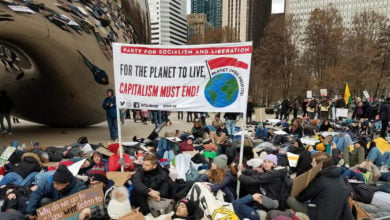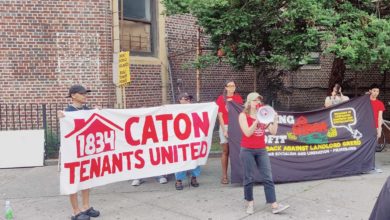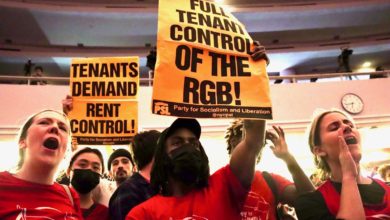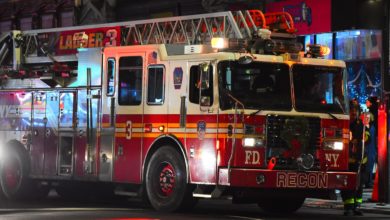Every year in the United States, more than 3 million people experience a period of homelessness, nearly half of them children, according to a report by the National Law Center on Homelessness and Poverty.
During the same period, as many as 18 million housing units stood vacant. Another 2-3 million homeowners, many of them with “subprime” mortgages, lost their homes to foreclosure and repossession from 2008 to 2012. This trend in foreclosure is likely to continue in 2013, according to the New York Federal Reserve.
The vacancy rates have gotten so bad – dragging down property values, unable to be resold for a profit – that in selected metropolitan areas, the banks have decided to demolish perfectly good homes rather than try to resell them. The situation is absurd: Homes sit vacant, or are even destroyed, while children sleep in shelters or in the streets.
It does not end there. The housing crisis has wreaked havoc throughout the broader economy. When the housing bubble burst, the massive financial speculation built around the industry was revealed to all. Some of the largest and mightiest banks essentially collapsed, only to be revived by a taxpayer bailout amounting to trillions of dollars.
There have been tens of thousands of layoffs in housing-related industries – construction, finance and real estate. Banks worldwide have tightened their credit flows, especially to working class families. As workers were hit by the crisis, consumer spending declined and the downturn rippled through other areas of the economy.
Capitalist overproduction
How was it that the richest country in the world, employing an army of economists in think tanks, universities and government departments, found itself in an inescapable economic downturn that threw millions out of work and onto the street? Why did these financial geniuses with PhDs and MBAs not see where the economy was headed and steer it in another direction?
It is because capitalism is a system that operates with one purpose: profits for individuals and corporations. This overarching logic determines how the capitalist owners and their administrators act and think. It also creates inescapable contradictions in the structure of the economy.
In the search for ever-higher profit margins and in competition with each other for greater market share, the capitalists produce far more of a given commodity than can be sold at the same rate of profit. The companies start to lower prices, hoping to sell the commodities they have produced – but there are no more buyers to be found. Investors pull out their capital, and the companies lay off workers and cut down operations in order to save their rate of profit.
This wasteful phenomenon of overproduction occurs on a small scale all the time, leading to layoffs and factory shutdowns. But periodically – when enough capital is wrapped up in the plummeting industry or industries – it leads to generalized economic recession or depression. This is called a crisis of overproduction.
That is what drove the housing crisis. It is a phenomenon unique to capitalism. In previous social systems, economic crises were produced by national calamities – floods, droughts, hurricanes, earthquakes – leading to extended periods of food scarcity and starvation. Under capitalism, such economic crises emerge not because society has produced too little but because it has produced “too much”. That does not mean too much in terms of meeting human needs, but too much to be sold at a profit.
Unable to stop itself
Under capitalism, workers are paid less than the value of the goods or services that they produce. The capitalist who employs the worker takes the remaining value – what socialist economists call surplus value, the basis for profit.
At the same time, each capitalist competes with other capitalists in order to return the highest reate of profit. To increase their rate of profit, capitalists try to find ways to cut the costs of production, through technological advances that can replace workers, cuts in wages and benefits, and outsourcing to lower-wage areas or countries.
In the short term, this leads to an immense return for the leading capitalists and individual investors. But over time the competing capitalists – if they are to survive – must find ways to replicate those technological advances, and the overall rate of profit again stabilizes or sinks even lower.
As the capitalist accumulates profit, the quest immediately begins to find new investments that can return the same high rate of profit previously enjoyed. Capitalists normally do not just let their money sit, no matter how much they have. Their investors, and the economy, require them to keep making profits.
In the late 1990s, as economic crisis swept across East Asia and later South America, investors worldwide started to invest heavily in U.S. Corporations and banks, which appeared more stable. The banks and corporations could not just let this money sit idle.
The ‘subprime’ crisis
How could the banks turn all that newly acquired capital into greater gains? They began to lower interest rates on mortgages, allowing more working-class families to purchase new homes on credit. This policy was in effect huge cash advance to the construction and banking industries – with the working class shouldering the risk.
Immediately, the construction industry began producing new homes and condominiums. Working class families were lured into purchasing homes at prices beyond what they could hope to pay on their constant or falling wages. At the same time, capitalists began purchasing homes and then immediately “flipping them” – reselling them at a higher price. Since the banks seemed to be a constant source of cheap credit, the new houses became more lavish and more expensive.
But the real-estate speculators built and purchased new houses without concern for the real needs and means of the buyers. In mid-2006, housing prices began to fall. Reports started surfacing about a spreading epidemic of foreclosures, as families defaulted on their loans. Many had been duped into accepting mortgages with enticing “teaser” rates that after a few yars reset to higher rates that were completely unaffordable.
In the summer of 2007, it became clear that virtually the entire banking system had massively inveted in the housing boom. Afraid they would not be getting back the money they had lent out, banks tightened up their credit and the entire economy teetered on the brink of disaster.
Now, millions of homes sit vacant in the United States – the most on record. “For sale” signs swing haplessly in the wind and real-estate agents organize open houses that nobody attends. The homes are too expensive for working class families, especially because credit is now harder to come by and it is now even harder to sell existing homes. The upper strata of society, the ruling class, is numerically too small to buy up and use all the condominiums and vacation homes that were built.
Residential construction ground to a halt and industries related to construction materials were put in grave danger. Many real-estate companies filed for bankruptcy and thousands of workers lost their jobs.
Despite the absurdity of the situation, it is hard to imagine a different outcome. The high rate of profit necessitated it. If one of the real-estate companies had instead invested in affordable, low-income housing, it would have lost all its investors to the competitors who promised higher rates of return. If one of the banks had shifted its money out of the housing market altogether, another bank would have taken its place.
Nor could the capitalists have coordinated with one another to prevent the overproduction of housing. To coordinate in such a way would destroy the individual capitalist’s competitive edge. It runs counter to the speculative instincts of a system based on competition.
The economic crisis was not caused by the bad decision-making of families, who were prodded at every turn to buy into the “American dream.” Nor is it simply the product of predatory lenders. Both of these explanations put the onus on wrong-doing individuals. The scale of foreclosure phenomenon shows that it comes from neither ignorance nor malice but from the very structure of the economy.
Generalized crises of overproduction have occurred roughly once per decade in the United States for the last 150 years. The current economic crisis, a product of overproduction and the over-accumulation of capital, is an inevitable outcome of the logic of the economic system.
Although the production and reproduction of the economy draws in millions of workers, who consciously are owned by a tiny minority who compete with one another based on profit. Enormous technological advances are wasted because the economy as a whole is unplanned, anarchic and thus prone to disaster.





